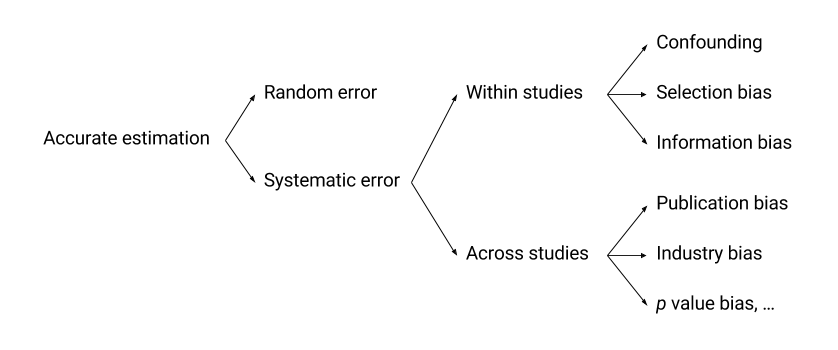Introduction
Clinical epidemiology provides the scientific basis for assessing and measuring the effects of medical interventions. It provides tools for designing, undertaking, reporting and interpreting clinical studies.
Much of clinical epidemiology is concerned with inferring whether the drug (or other intervention) has an effect on a clinical outcome—this is a “yes” or “no” question—and, if there is an effect, estimating the size of that effect on the outcome—this is a magnitude question. Study design and statistics play an important role in determining what kind of inferences about the effects of a drug are warranted.
- Bias
refers to any systematic error in estimating the effect of a drug, exposure or risk factor on a specified outcome

A map of different types of bias that lead to inaccurate estimation
The figure is partially based on the discussion provided in Rothman, Greenland, and Lash (2008), 128. The bias map provides a way to think about how a clinical study’s results may be inaccurate.
Statistics is primarily concerned with minimising random error. Trial design and many other tools of clinical epidemiology are concerned with minimising systematic error.
This activity focuses on statistics and measures of effect. You have discussed trial design in other parts of the course.
The overall objectives of this learning activity are:
Objectives
- Understand the logic of statistical testing in clinical trials
- Demonstrate an understanding of key statistical concepts: hypothesis testing, \(p\) values, confidence intervals and power
- Be able to describe and interpret common measures of effect used in clinical epidemiology
A number of tasks are suggested throughout to test your ability to apply the concepts.
References
Rothman, Kenneth J, Sander Greenland, and Timothy L. Lash. 2008. “Validity in epidemiologic studies.” In Modern Epidemiology, edited by Kenneth J Rothman, Sander Greenland, and Timothy L Lash, 3rd ed., 128–47. Philadelphia: Lippincott Williams & Wilkins. https://doi.org/10.1016/B978-0-443-06954-3.00009-8.